|
The Lunar Society
The Society
was a dining club and informal learned
society of prominent industrialists, natural philosophers and
intellectuals who met regularly between 1765 and 1813 in Birmingham,
England.
The members of the Lunar
Society were very influential in Britain. Amongst those who attended
meetings more or less regularly were Matthew Boulton, Erasmus Darwin,
Samuel Galton Junior, James Keir, Joseph Priestley, Josiah Wedgwood I,
James Watt, John Whitehurst and William Withering.
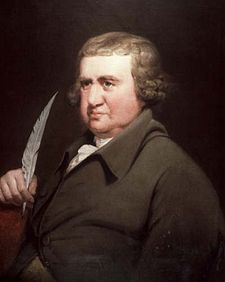
Erasmus
Darwin 1731-1802
Grandfather of Charles Darwin |
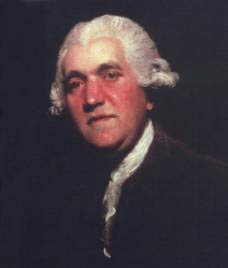
Josiah Wedgwood I
1730-1795
Grandfather of Charles Darwin |
Family relationships and
Charles Darwin the naturalist:-
-
Josiah Wedgwood I married Sarah Wedgwood (a
third cousin). Together, they had seven children including Susannah
Wedgwood (1765Ė1817) who married Robert Darwin.
-
Robert Darwin was the son of Erasmus Darwin
and his first wife Mary Howard.
-
Susannah Wedgwood and Robert Darwin were the
parents of the English naturalist Charles Darwin.
Josiah Wedgwood I and
Erasmus Darwin:
1762
Josiah was first introduced to Erasmus Darwin by Matthew Turner, a
surgeon who was treating Josiah's leg injury.
1765
Josiah Wedgwood and Erasmus Darwin's relationship was cemented when
Darwin became an enthusiastic supporter of the Grand Trunk (Trent and
Mersey) Canal scheme.
1767
In 1767 Darwin introduced Wedgwood to Matthew Boulton who was a
Birmingham metal works owner. Boulton had a new state-of-the-art works and
employed 500 plus with an annual turnover of £30,000 (compared with
Wedgwood's workforce of 100 and turnover of around £5-6,000). Josiah
Wedgwood was particularly impressed with a well built lathe in Boulton's
works.
February 1768
Darwin proposed to Wedgwood that he install a 'Horizontal Wind-mill'
which Darwin had invented. Eventually Wedgwood was convinced of the novel
windmill's benefits and one was installed at his Etruria works in 1779.
This windmill operated for thirteen years until replaced by a Boulton and
Watt's steam engine.
28 May 1768
Dr Erasmus Darwin and Thomas Bentley, together with two surgeons were
in attendance at Josiah Wedgwood's home at the Brick House Works, when
continuing trouble with his smallpox-afflicted knee made necessary the
amputation of Wedgwood's right leg.
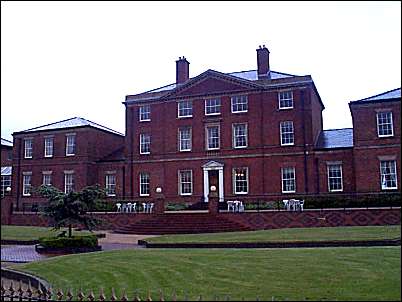
Wedgwood's home in
Etruria - built c.1770
Erasmus Darwin said of it
"fit for a prince"
Darwin was a regular visitor to Etruria
Hall, attending to Wedgwood's wife Sarah. Likewise Wedgwood and his family
visited Darwin's home in Lichfield. Some of Wedgwood's children spent a
month there learning French from a French prisoner that Erasmus hired to
teach them.
November 1780
Josiah Wedgwood's friend and business partner died leaving Josiah was
grief-stricken. Erasmus Darwin, still coping with the recent of one of his
sons, gave Josiah a great deal of support.
1789
After three years work, Wedgwood had finally produced successful
copies of the Portland Vase - one of the first copies was sent to Erasmus
Darwin.
January 1795
Erasmus Darwin had recently been attending Josiah as his health
deteriorated and on New Year's Day Wedgwood slipped into unconsciousness,
two days later he died.
"The death of Mr Wedgwood grieves me very
much.... He is a public as well as private loss"
Erasmus Darwin

|
Maer and the Wedgwood / Darwin families
Maer is a rural village in the Borough
of Newcastle-under-Lyme, Staffordshire, it lay only 7 miles (11 km)
from the Etruria Works of the pottery manufacturer Wedgwood.
The main feature of the village is the
large 17th century stone built country house Maer Hall built on a
slope above a small lake, or "mere", which gave the house and estate
its name. In 1802 Josiah Wedgwood II bought the house using funds
borrowed from his relative Robert.
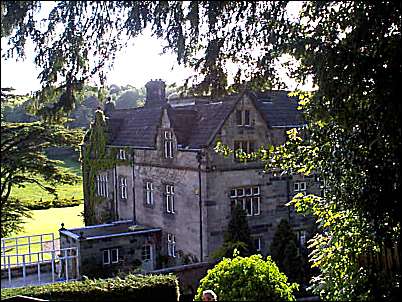
The large 17th
century stone built country house and estate of Maer Hall
Its location in the
district of Newcastle-under-Lyme, Staffordshire, England, is
attractively rural, but fairly close to the pottery manufacturing area
around Stoke-on-Trent which attracted its most famous owner Josiah
Wedgwood II. His nephew Charles Darwin often visited Maer, and married
Josiah's daughter Emma.
Charles Darwin proposed to Emma Wedgwood
at Maer Hall, and they were married at St. Peterís Church which stands
close by on the hillside overlooking the Hall.
When she was young Emma helped her older
sister Elizabeth with the Sunday School which was held in Maer Hall
laundry, giving sixty village children their only formal training in
reading, writing and religion.
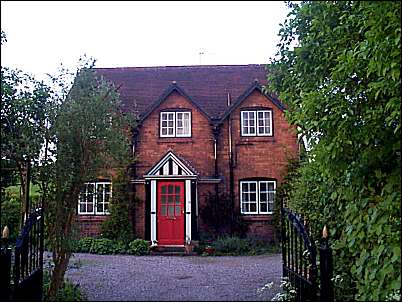
Maer Hall laundry
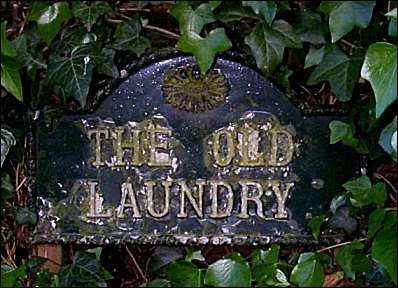
The Hall became the home of Josiah
Wedgwood II and was frequently visited by his nephew Charles Darwin
who went on to marry Josiah's daughter Emma at St. Peterís Church
which stands higher on the hillside, close to the Hall.
There was a pleasant freedom of speech
in the Wedgwood family, with everyone speaking their mind without
restraint. They frequently exchanged visits to and from their Darwin
relatives only 20 miles (30 km) away, and the young Charles Darwin
found it a welcome contrast to the stricter approach of his father.
Charles gained much useful information from his relatives during the
inception of Darwin's theory, and it was at Maer Hall that he first
became interested in the effects of earthworms which were the subject
of an early paper presented to the Geological Society as well as of
his last book.
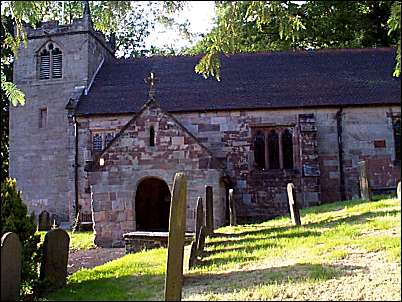
St. Peter's
Church, Maer
where Emma Wedgwood and Charles Darwin were married
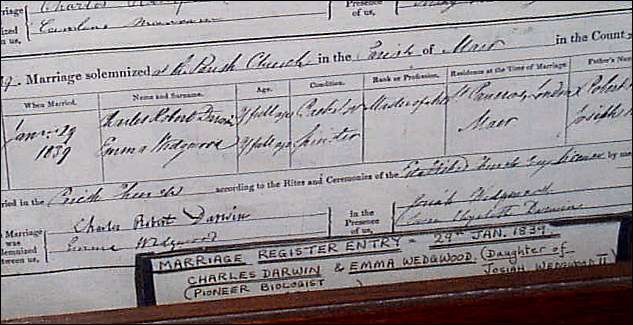
Charles Darwin and
Emma Wedgwood marriage certificate
29th January 1839
The grave of Josiah Wedgwood II and his
wife Elizabeth in the churchyard has a view down over the Hall.
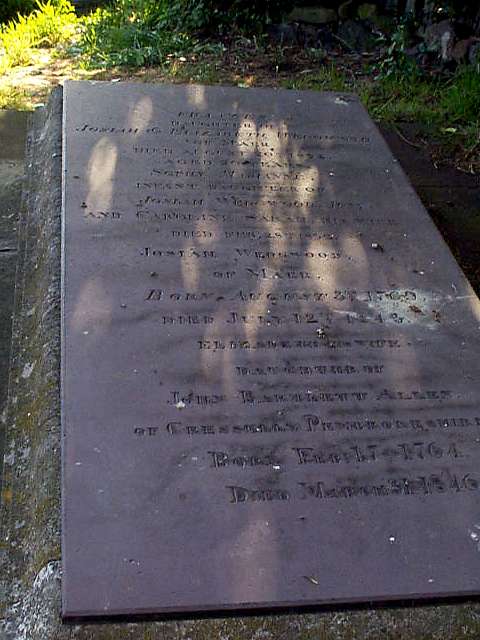
The grave of Josiah
Wedgwood II
Josiah Wedgwood, Darwin's uncle, died on 12 July 1843
Maer photos: Steve Birks May 2000
|

|
![]()